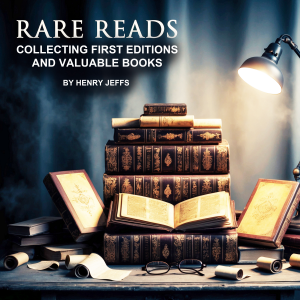

Rare Reads
Henry Jeffs
This audiobook is narrated by a digital voice.
In the quiet corner of a used bookstore, beneath layers of dust and forgotten dreams, lies a treasure more valuable than gold to those who understand its worth. The first edition represents something profound in human culture: the moment when an idea first took physical form and entered the world. It is the original manifestation of an author's vision, unmarked by subsequent revisions, corrections, or the passage of time that inevitably changes how we perceive and present literature.
The fascination with first editions extends far beyond mere collecting. Each first edition book carries within its pages the excitement of discovery, the uncertainty of reception, and the hope that accompanied its initial publication. When Charles Dickens first published "A Christmas Carol" in 1843, neither he nor his publisher could have predicted that this slim volume would become one of the most beloved stories in English literature. The first edition copies, with their original salmon-colored endpapers and hand-colored frontispiece, now command prices that would have seemed astronomical to their original purchasers.
Understanding what makes a book truly rare requires delving into the complex interplay of factors that determine literary value. Rarity alone does not guarantee worth; a book must possess a combination of scarcity, demand, historical significance, and condition to achieve true collectible status. The principles that govern rare book valuation have evolved over centuries, shaped by changing tastes, historical events, and the natural attrition that affects all physical objects over time.
Duration - 38m.
Author - Henry Jeffs.
Narrator - Digital Voice Archie G.
Published Date - Tuesday, 21 January 2025.
Copyright - © 2025 Henry Jeffs ©.
Location:
United States
Description:
This audiobook is narrated by a digital voice. In the quiet corner of a used bookstore, beneath layers of dust and forgotten dreams, lies a treasure more valuable than gold to those who understand its worth. The first edition represents something profound in human culture: the moment when an idea first took physical form and entered the world. It is the original manifestation of an author's vision, unmarked by subsequent revisions, corrections, or the passage of time that inevitably changes how we perceive and present literature. The fascination with first editions extends far beyond mere collecting. Each first edition book carries within its pages the excitement of discovery, the uncertainty of reception, and the hope that accompanied its initial publication. When Charles Dickens first published "A Christmas Carol" in 1843, neither he nor his publisher could have predicted that this slim volume would become one of the most beloved stories in English literature. The first edition copies, with their original salmon-colored endpapers and hand-colored frontispiece, now command prices that would have seemed astronomical to their original purchasers. Understanding what makes a book truly rare requires delving into the complex interplay of factors that determine literary value. Rarity alone does not guarantee worth; a book must possess a combination of scarcity, demand, historical significance, and condition to achieve true collectible status. The principles that govern rare book valuation have evolved over centuries, shaped by changing tastes, historical events, and the natural attrition that affects all physical objects over time. Duration - 38m. Author - Henry Jeffs. Narrator - Digital Voice Archie G. Published Date - Tuesday, 21 January 2025. Copyright - © 2025 Henry Jeffs ©.
Language:
English
Start
Duration:00:38:40